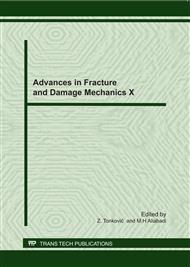p.626
p.630
p.634
p.638
p.642
p.646
p.650
p.654
p.658
Experimental Fracture Behavior of Polypropylene Fiber Reinforced Concrete Specimens with Variable Width
Abstract:
This paper presents a study of the influence of polypropylene fiber reinforcement of concrete on the fracture behavior and edge effect in elements of variable width. Experimental results of fracture behavior of specimens with different cross sections are available. It has obtained more ductile behavior for specimens with trapezoidal sections (with increasing width) and inverted T-sections. Therefore, we analyze the influence of the fibers addition on the fracture behavior of these sections. Sections with gradual variation of wide and sudden change of width were analyzed. Results allow us to quantify the increase of ductility and fracture performance improvements produced by polypropylene fiber addition to concrete in these sections.
Info:
Periodical:
Pages:
642-645
Citation:
Online since:
September 2011
Authors:
Price:
Сopyright:
© 2012 Trans Tech Publications Ltd. All Rights Reserved
Share:
Citation:


